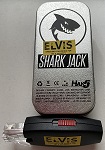Difference between revisions of "Hak5 Shark Jack"
Jump to navigation
Jump to search
| Line 2: | Line 2: | ||
[[File:Shark_Jack.jpg |thumb|right|600px||Shark Jack]] | [[File:Shark_Jack.jpg |thumb|right|600px||Shark Jack]] | ||
The Shark Jack is a penetration tool for penetration testers and system administrators looking like a simple USB-Stick. It provides possibilities to perform network audits and information gathering attacks. These function are provided by the packages which are installed on the Shark Jack. The packages are provided by the OpenWRT platform, which means that users can add other packages than the preinstalled ones. | The Shark Jack is a penetration tool for penetration testers and system administrators looking like a simple USB-Stick. It consists of three main components: a LAN-Port for configuration and executing pentests (which also uses a RGB-LED for visual responses), a USB-C port for charging and a slider to change modes. It provides possibilities to perform network audits and information gathering attacks. These function are provided by the packages which are installed on the Shark Jack. The packages are provided by the OpenWRT platform, which means that users can add other packages than the preinstalled ones. | ||
== Description == | == Description == | ||
Revision as of 11:05, 19 December 2021
Summary
The Shark Jack is a penetration tool for penetration testers and system administrators looking like a simple USB-Stick. It consists of three main components: a LAN-Port for configuration and executing pentests (which also uses a RGB-LED for visual responses), a USB-C port for charging and a slider to change modes. It provides possibilities to perform network audits and information gathering attacks. These function are provided by the packages which are installed on the Shark Jack. The packages are provided by the OpenWRT platform, which means that users can add other packages than the preinstalled ones.
